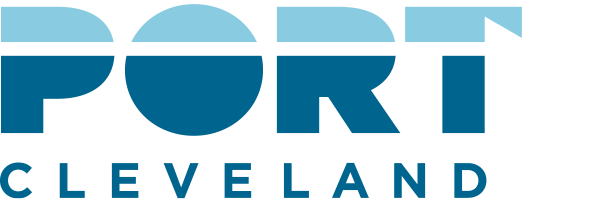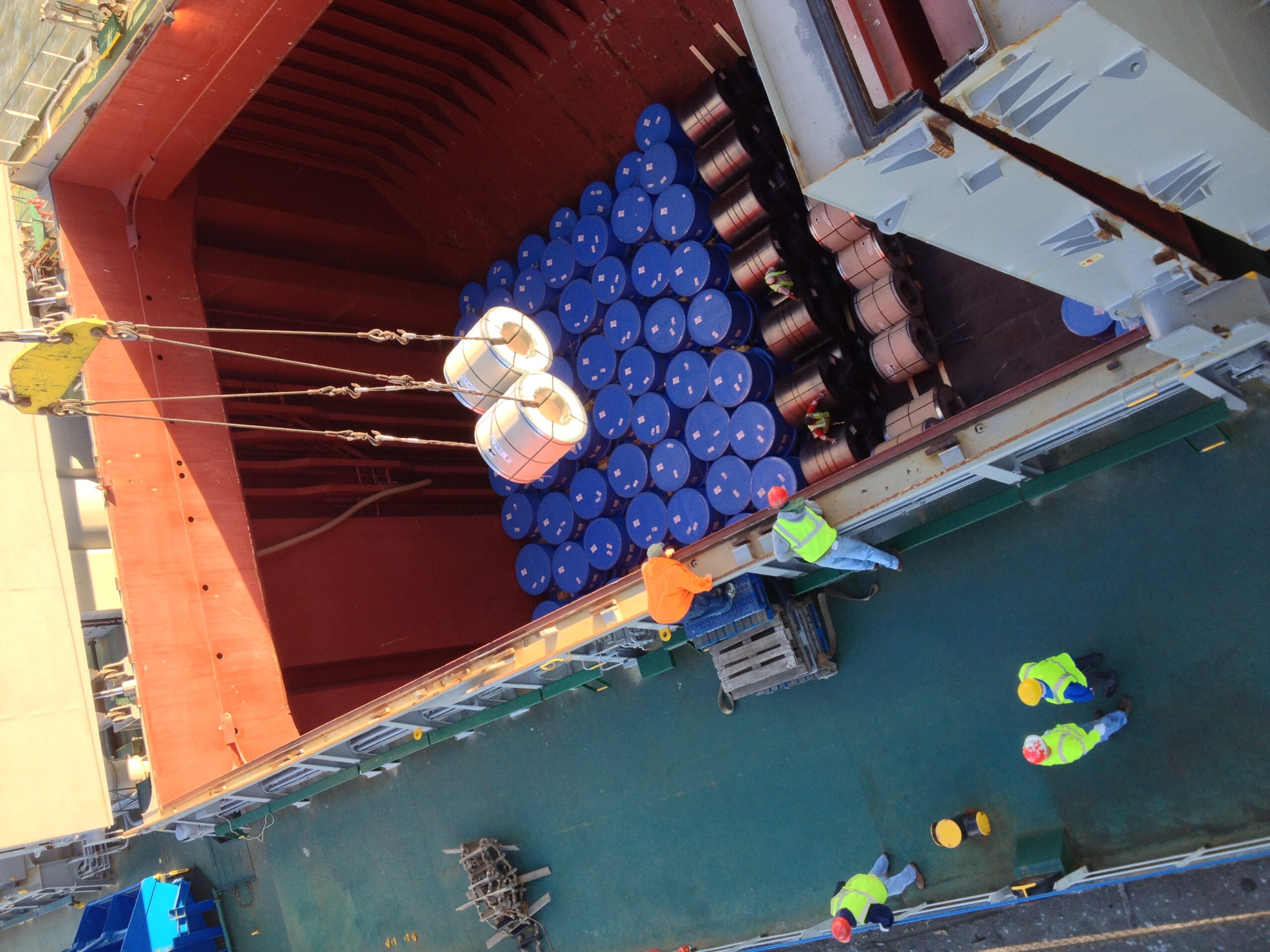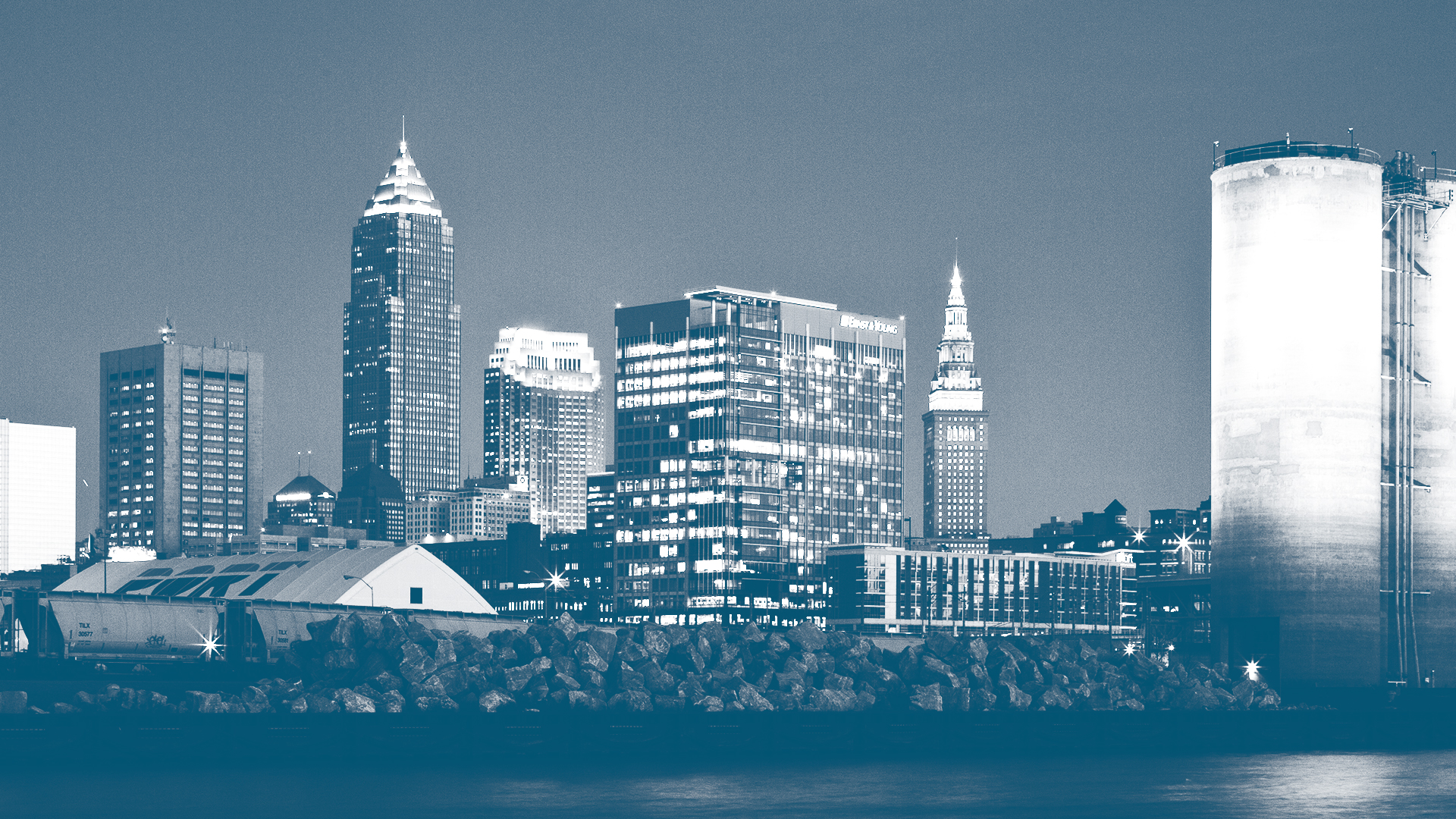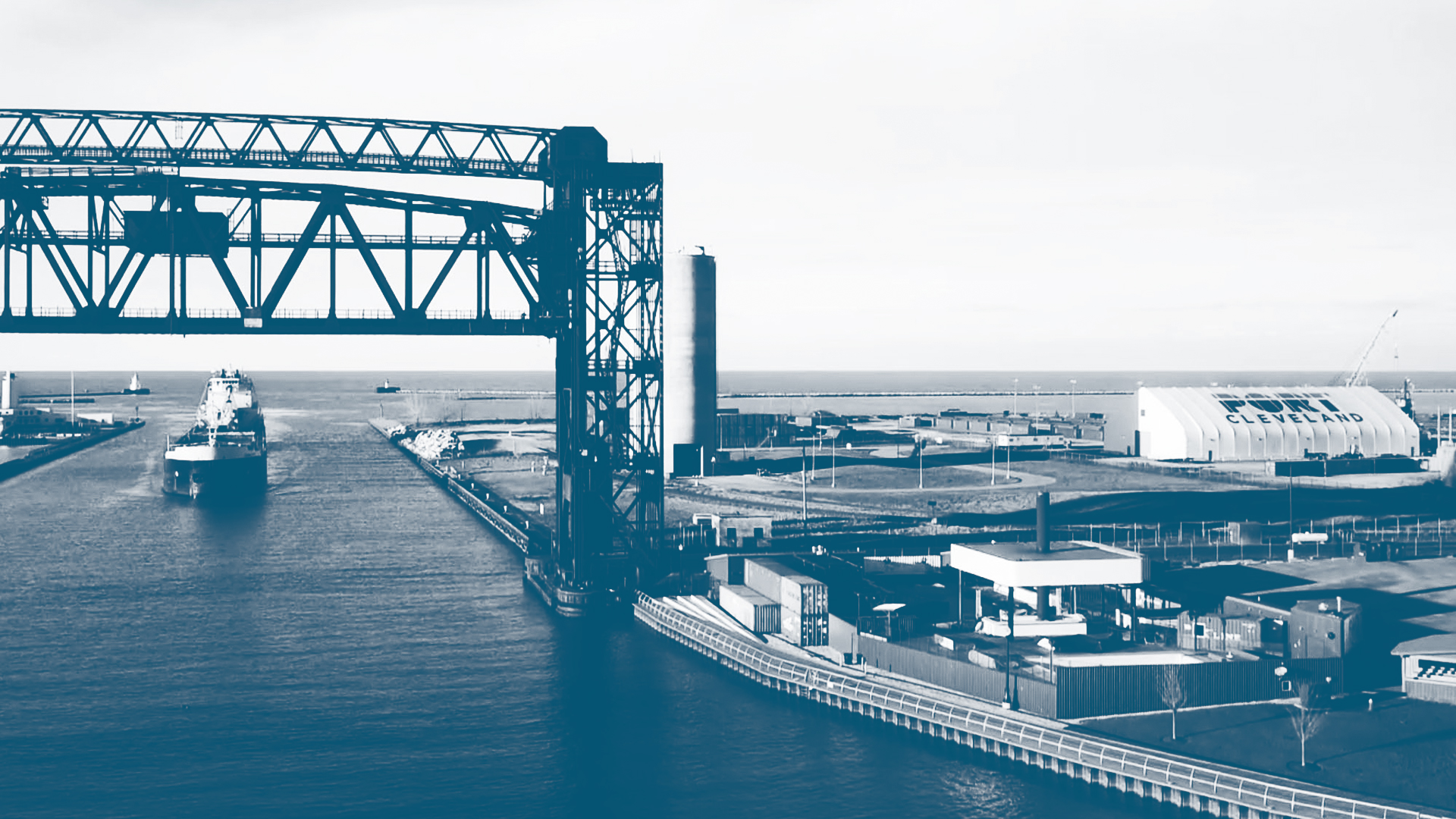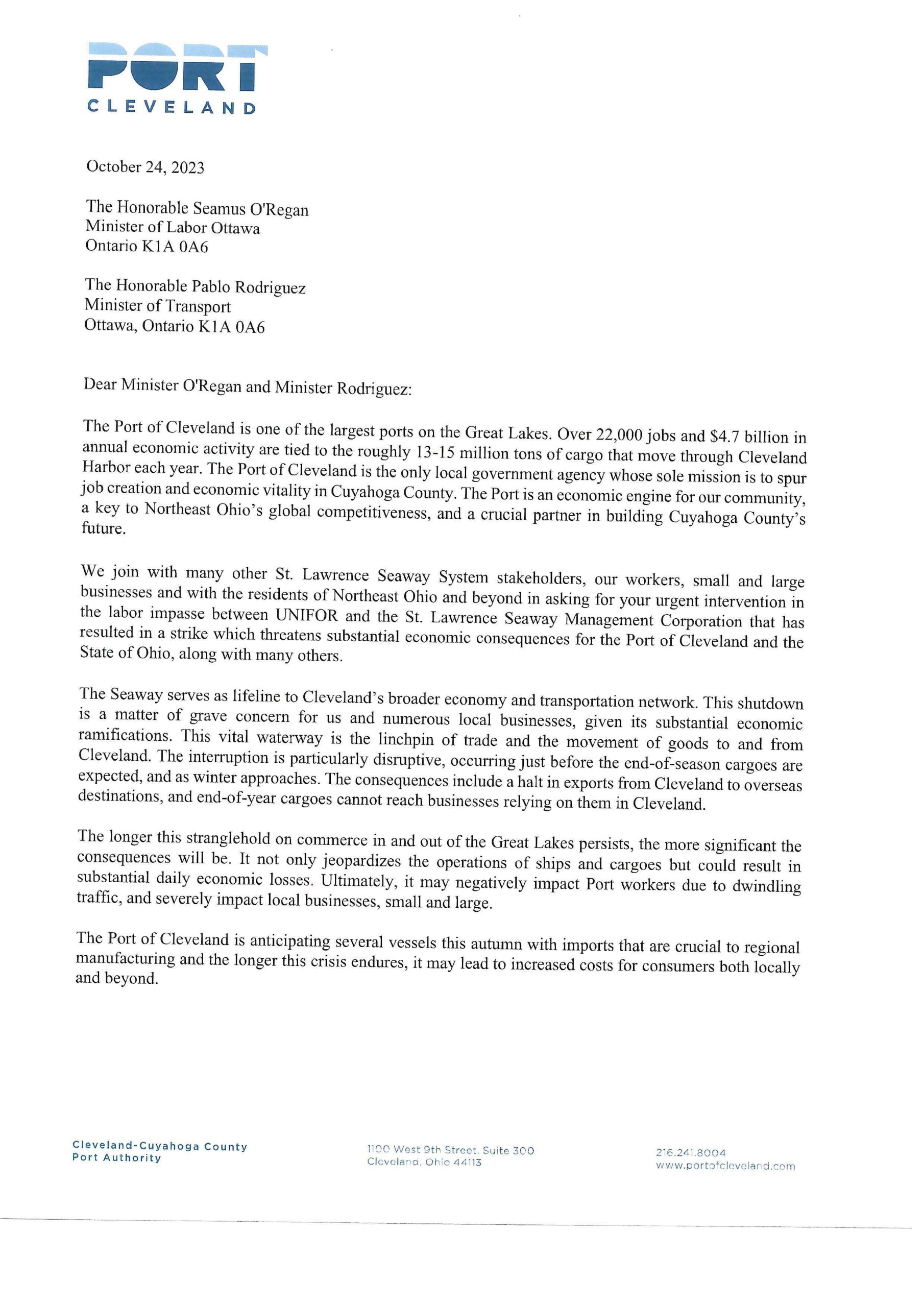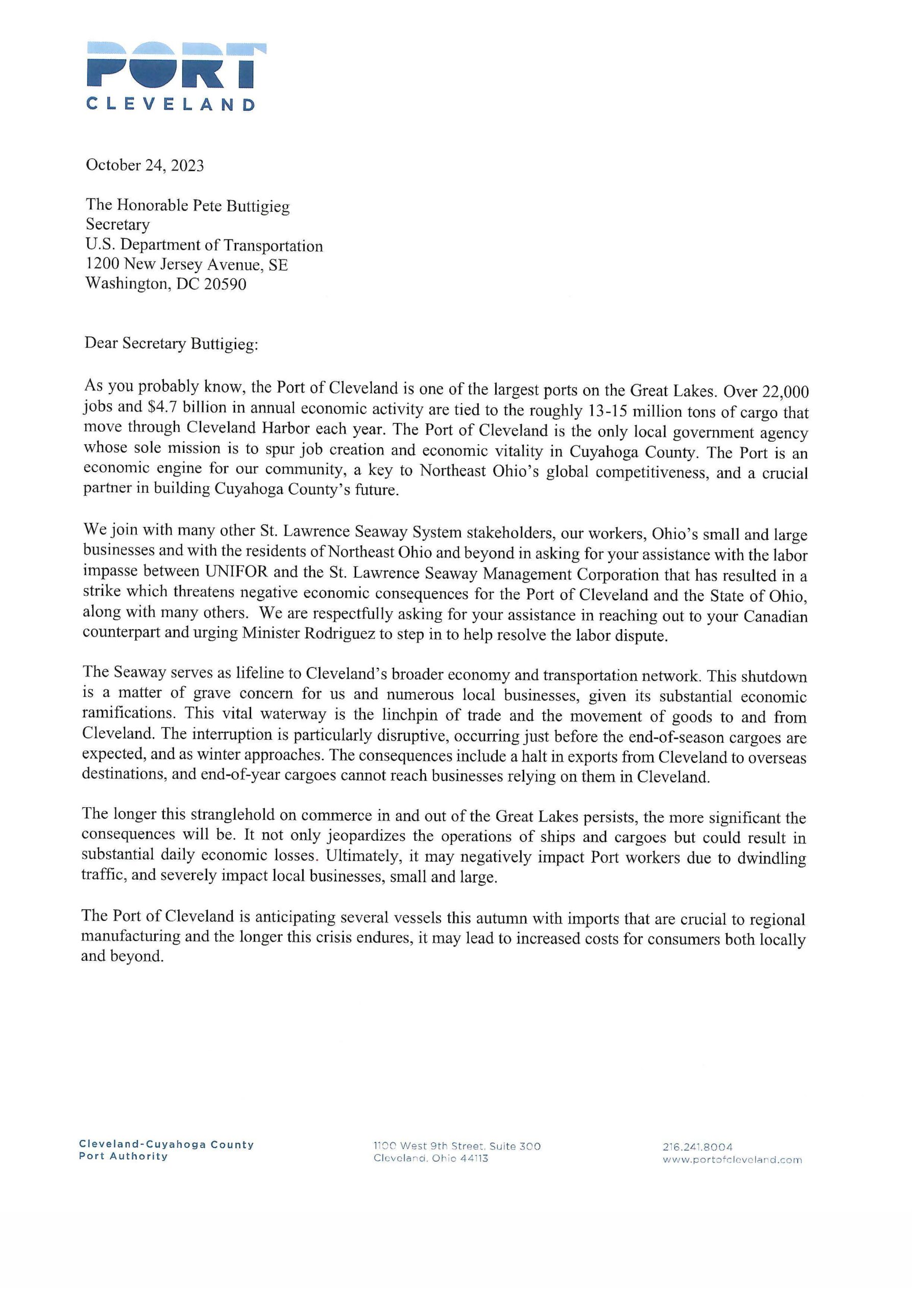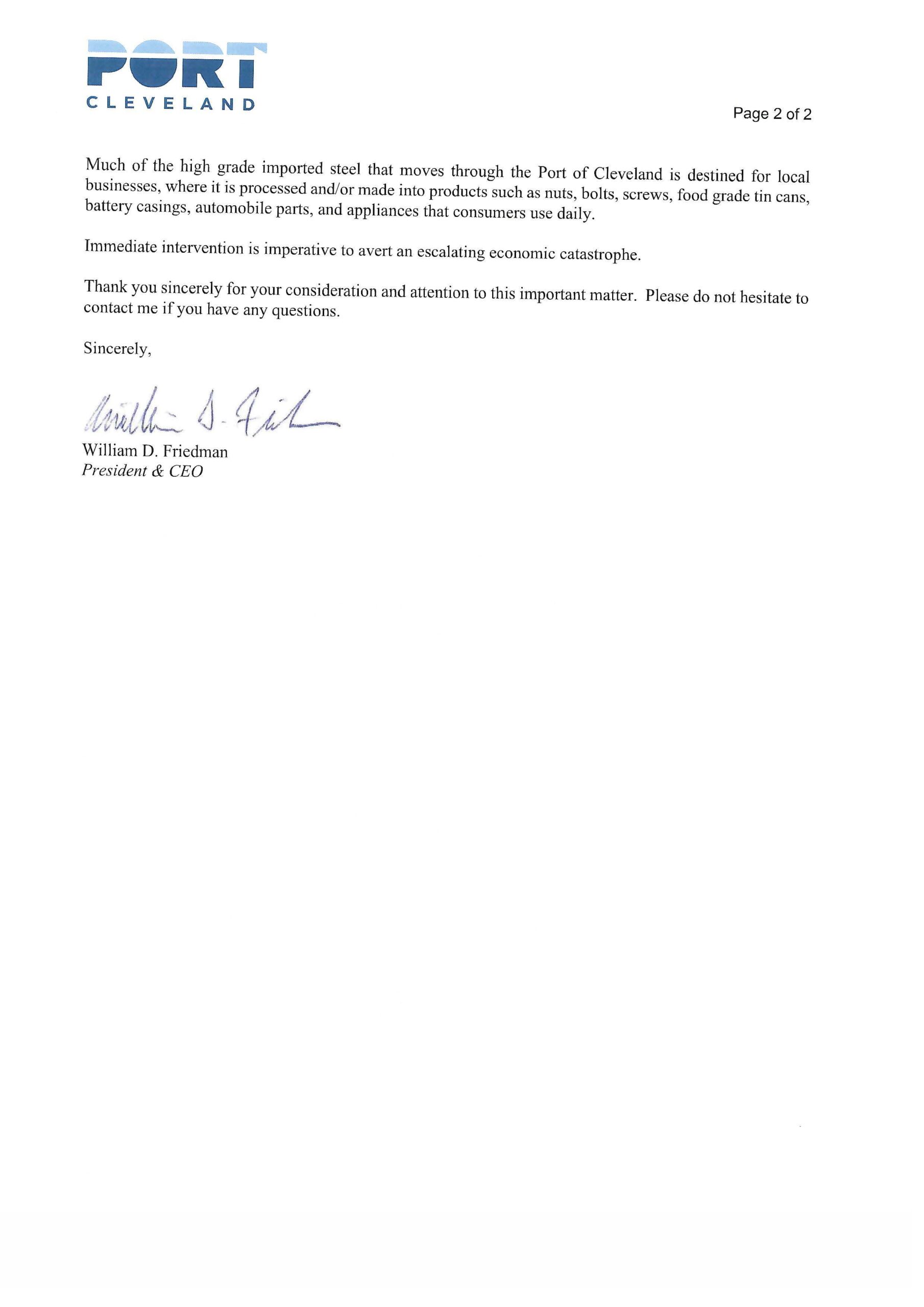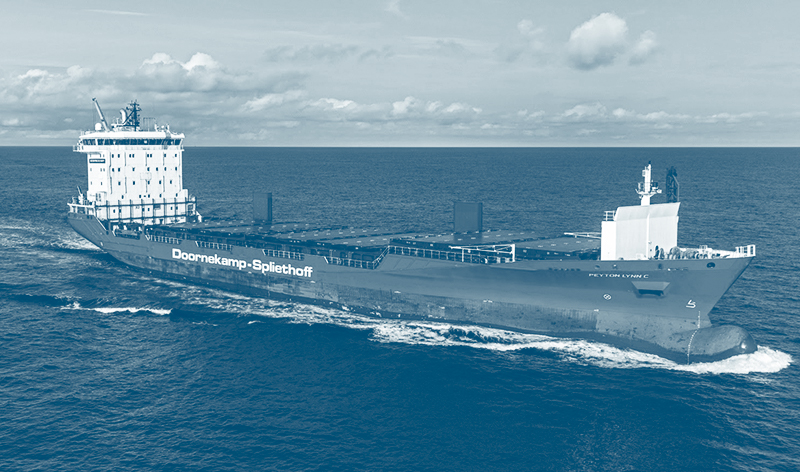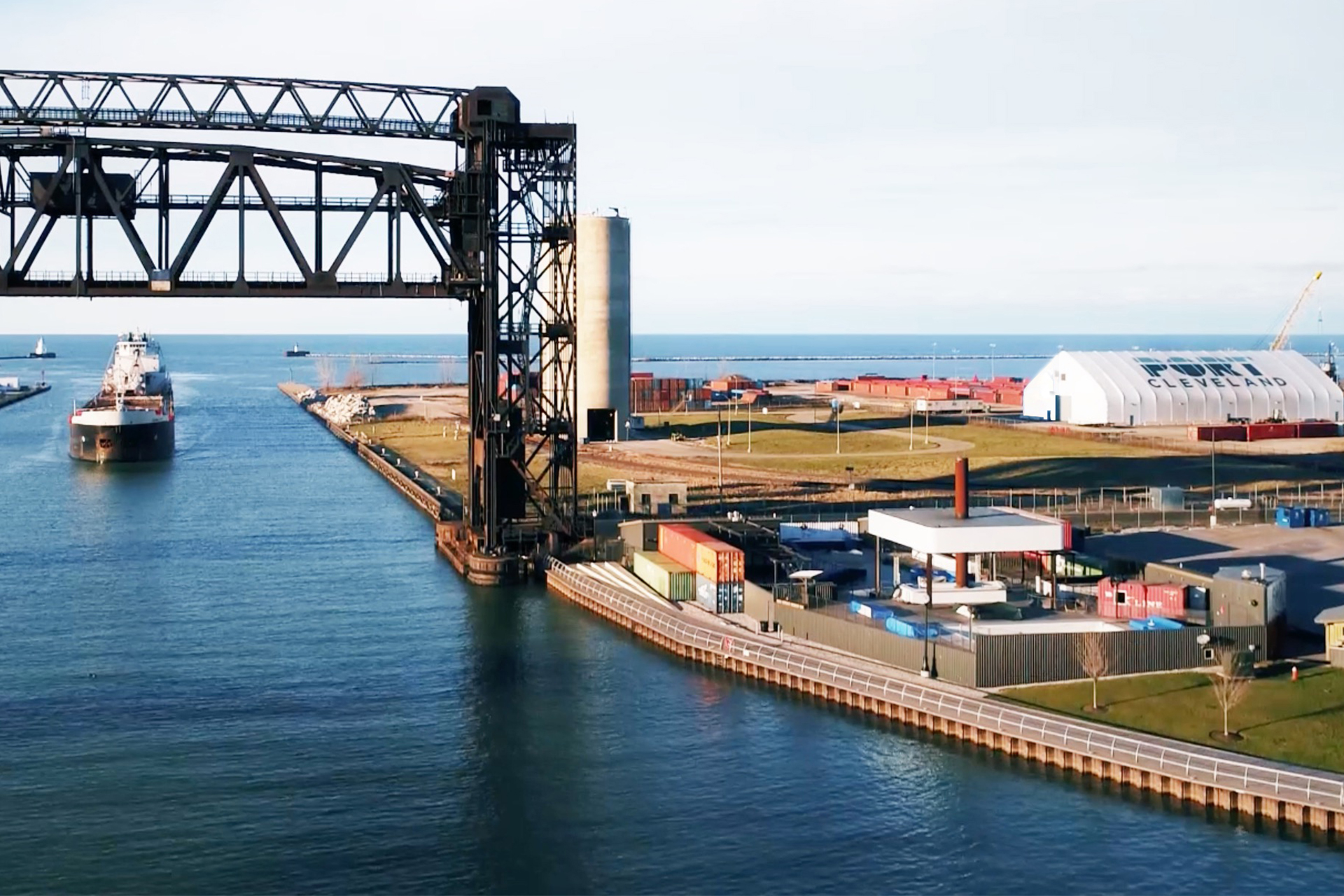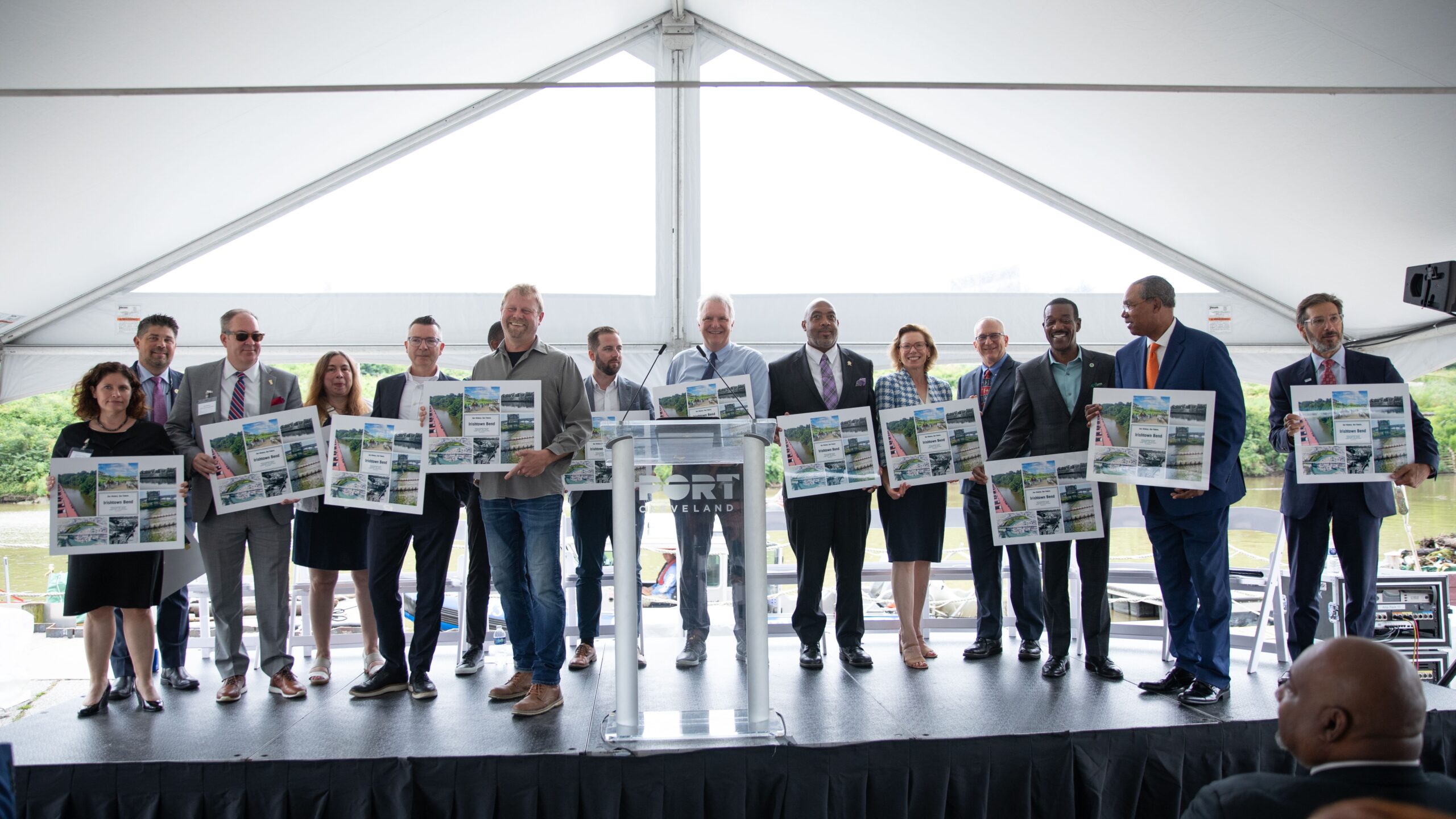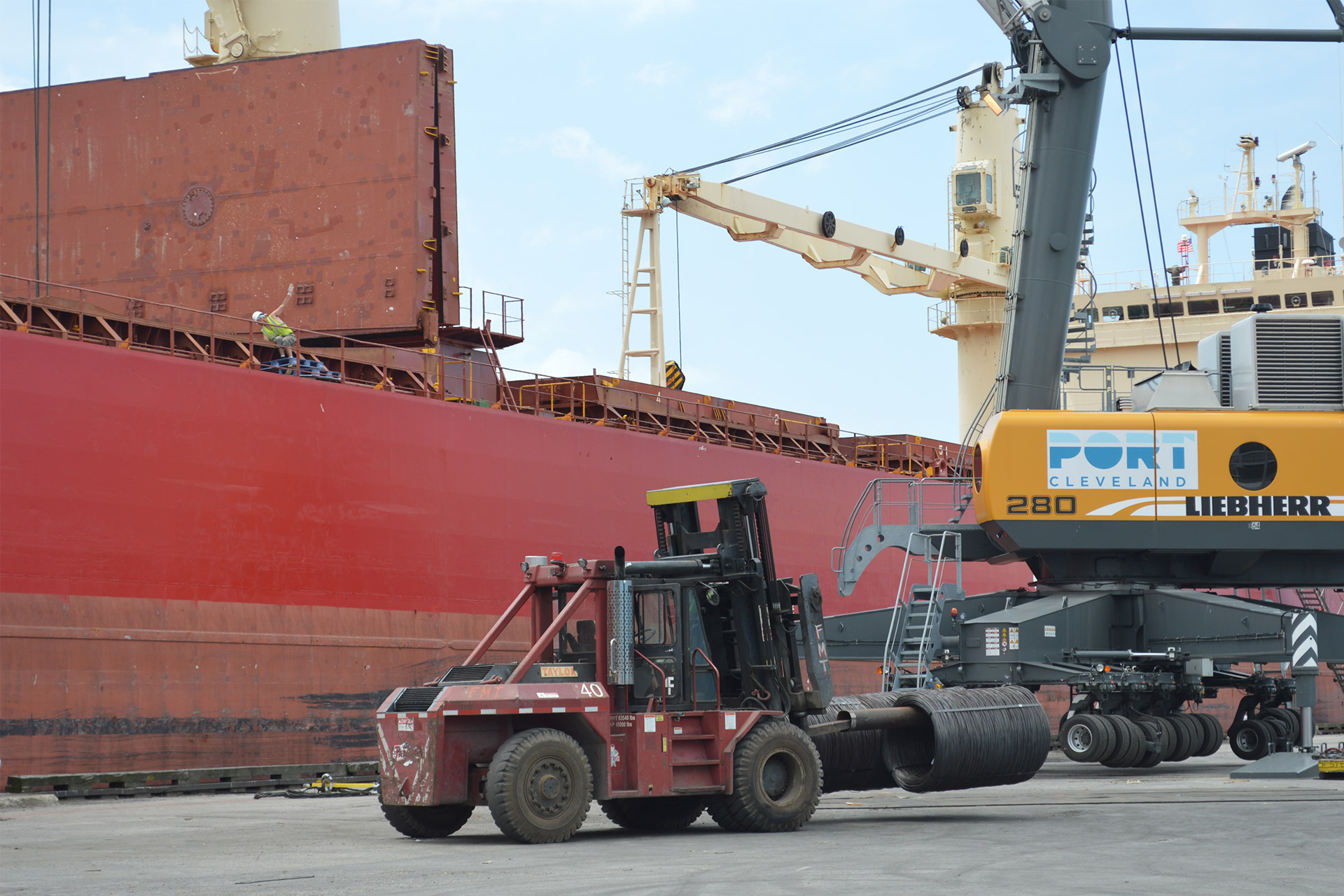Challenges, Delays Lead to Pause on Lake Erie Wind Turbine Project
Cleveland – December 8, 2023 — Citing considerable challenges and increased costs resulting from years of delays and obstacles, the Lake Erie Energy Development Corp. (LEEDCo) board of directors made the difficult decision to temporarily halt the Icebreaker Wind project. This innovative project, consisting of six wind turbines, was planned to be located eight miles off Cleveland’s shoreline.
The board is exploring various avenues that might allow the project to move forward in the future.
“We join with many civic leaders, businesses and environmental organizations in being disappointed in having to suspend this project,” said Will Friedman, LEEDCo board member and president & CEO of the Port of Cleveland. “This pause is necessitated by a confluence of adverse circumstances and numerous delays resulting in a financial climate where the project’s commercial viability is in question.”
The project’s development efforts began around 2009. Since that time, it received approvals from numerous local, state and federal agencies. But there were significant regulatory and legal hurdles.
Specifically, LEEDCo pointed to a project killing condition by the Ohio Power Siting Board (OPSB) which significantly impeded the project by mandating that Icebreaker cease operations in the evening, making it financially untenable. The State’s own experts testified under oath the shutdown mandate wasn’t needed. This provision was ultimately reversed, but the lengthy delay significantly dimmed prospects for advancing the project.
Friedman emphasized that LEEDCo invested great amounts of time reviewing any potential impact on birds. Siting Board staff determined after 18 months of extensive study and review that with certain conditions, Icebreaker Wind “serves the public interest” and poses “minimal adverse environmental impact.” After thorough review, the U.S. Fish and Wildlife Service stated the project poses “limited direct risk” to migratory birds. And many environmental groups have endorsed Icebreaker, including the Sierra Club, the Environmental Defense Fund and the Ohio Environmental Council.
Additionally, Icebreaker Wind faced frivolous and costly lawsuits funded by dark money tied to fossil fuel interests. This burdensome litigation caused years of delays and significant expense. The delays have led to a constrained economics for the project:
- Higher interest rates have driven up financing costs. General inflation and global circumstances have significantly increased capital costs, especially for materials like steel, making offshore wind particularly susceptible to economic fluctuations. While LEEDCo is a small non-profit, other projects being pursued by the world’s leading offshore wind developers, with government support, are being stalled by similar factors.
- LEEDCo’s private development partner, which was to construct and operate the project, ceased financial support for Icebreaker due to the numerous obstacles presented. Friedman said LEEDCO is open to the possibility of other developer-owners taking over the project.
- LEEDCo and the U.S. Department of Energy’s Office of Energy Efficiency and Renewable Energy have mutually agreed to terminate a funding award given the delays and the practical inability to meet the Department’s award milestones. While this award has terminated, the federal government continues to prioritize offshore wind and there might be future opportunities for funding.
LEEDCo Board Chair Ronn Richard, who was central in conceiving the project, said Northeast Ohio was poised to be a leader in innovation with this potential first of its kind offshore wind project in North American fresh water.
Richard said the community’s efforts have not been in vain. “LEEDCo has conducted extensive, expert research about the environmental sustainability of offshore wind, laying the groundwork for future projects,” he said. “We have sparked a meaningful community conversation about the potential offshore wind can provide and the importance of renewable energy. “
Richard noted many companies in Northeast Ohio and throughout the state have set ambitious renewable targets, underscoring the need for clean energy.
“I maintain my belief that – just as Ohio was the first in flight – the day will come when Ohio will be a leader in advanced energy. I am disappointed by this pause on Icebreaker, but I believe that there will be a significant number of offshore wind turbines in the Great Lakes in my lifetime. Climate change will necessitate it,” Richard added.
Chris Tavenor, associate general counsel for the Ohio Environmental Council, also is optimistic.
“LEEDCo was ahead of its time when it proposed the Icebreaker Wind Project, the first freshwater offshore wind farm in North America. This innovative project has persevered through significant legal and regulatory challenges that in some cases were funded by the fossil fuel industry,” he said. “For decades, the Ohio Environmental Council has worked to grow Ohio’s renewable energy future by advocating for smart investments that provide Ohioans with clean, affordable energy. That includes the Icebreaker Wind Project, with its potential to reduce carbon emissions and inject millions into the local economy. While we are disappointed by the temporary pause of this innovative clean energy project, we remain optimistic about the potential of offshore wind for Ohio and other Great Lakes states.”
The LEEDCo board extended its thanks to multiple partners including local and state elected officials who were advocates, environmental groups, labor organizations and others who were staunch advocates.
About Icebreaker Wind
Icebreaker Wind was anticipated to create over 500 jobs and pump $253 million into the region’s economy. Ohio already has the largest wind energy manufacturing base of any state in the US, according to the American Wind Energy Association. More than 275 manufacturing companies had expressed interest in being part of the project.
The project received approvals from agencies including the Ohio EPA, the Federal Aviation Administration, the U.S. Coast Guard, the U.S. Army Corps of Engineers, the U.S. Fish and Wildlife Service, the Ohio Department of Natural Resources, and the Ohio Power Siting Board. The U.S. Department of Energy conducted an Environmental Assessment and issued a Finding of No Significant Impact.
Eight miles from shore, the proposed turbines would not be visible on most days. On a clear day, a person standing on the downtown Cleveland lakeshore holding their arm out would have seen turbines no taller than half a thumbnail. The small project would have only occupied .000002% of Lake Erie’s surface area.
# # # #
Tata Steel a key business and decarbonization partner for Port
Tata Steel and the Port of Cleveland recently both took part in the Green Shipping Corridor Network’s first working group session at the U.S. Department of Transportation in Washington, DC.
The focus is track emissions within the Great Lakes Seaway System as it drives towards decarbonization aspirations. Tata is the Port of Cleveland’s largest steel importer and client at the general cargo terminal.
Kevin Tyszkiewicz, Tata’s North American Logistics and Operations Manager, said Tata is firmly committed to decarbonization, just as the Port of Cleveland is.
“When we we talk to our supply chain partners and our business partners, we have a vested interest in both us and them doing green initiatives. It’s not just the end goal that’s important, but how do you get there? You can’t wait for others to find a solution,” said Tyszkiewicz.
“We’ve been encouraged that the Port of Cleveland has taken a leadership position within the Great Lakes on climate initiatives.”
He noted that Tata has been importing to the U.S. for more than 60 years “and Cleveland is core to our business.”
Rhonda Winslow is Making it her Business to Help Development Projects Access Funding
Rhonda Winslow captain’s the Port’s business development work, and has been with the Port since 2012 and now serves as the Port’s Vice President of Development Finance.
Recently, Rhonda won the prestigious NAIOP President’s Award from the Northern Ohio Chapter. This award recognizes individuals who encourage and support development and the local real estate community.
Rhonda oversees the development finance program, including over $1.5 billion in outstanding bonds issued through the Port’s development finance group.
“Rhonda has shepherded dozens of revenue bond issuances by our Port Authority to closing,’’ said Will Friedman. “These projects have had a huge impact on our community. Rhonda is a consummate pro who works tirelessly behind the scenes helping projects access capital.”
She has worked extensively on numerous high-profile projects in and around Northeast Ohio, including two Amazon distribution centers, the Flats East Bank Development, the Lumen in Playhouse Square, the Intro in Ohio City, and the Sherwin-Williams headquarters.
She has been a board member of the Ohio Chapter of Women in Public Finance since January 2019.
Rhonda earned a master’s degree in business administration and bachelor’s in accounting from The University of Akron. She is a Certified Public Accountant.
Prior to joining the Port, she was with the professional services firm PricewaterhouseCoopers LLP.
Rhonda calls Shaker Heights home, where she resides with her husband and two children, ages 1 and 3. In her free time, she’s an active volleyball player, a cyclist who explores the Towpath Trail and a fan of family outings to baseball games. Despite her move from the neighborhood, Rhonda’s favorite dining spots are Tremont’s Grumpy’s and Rowley Inn.
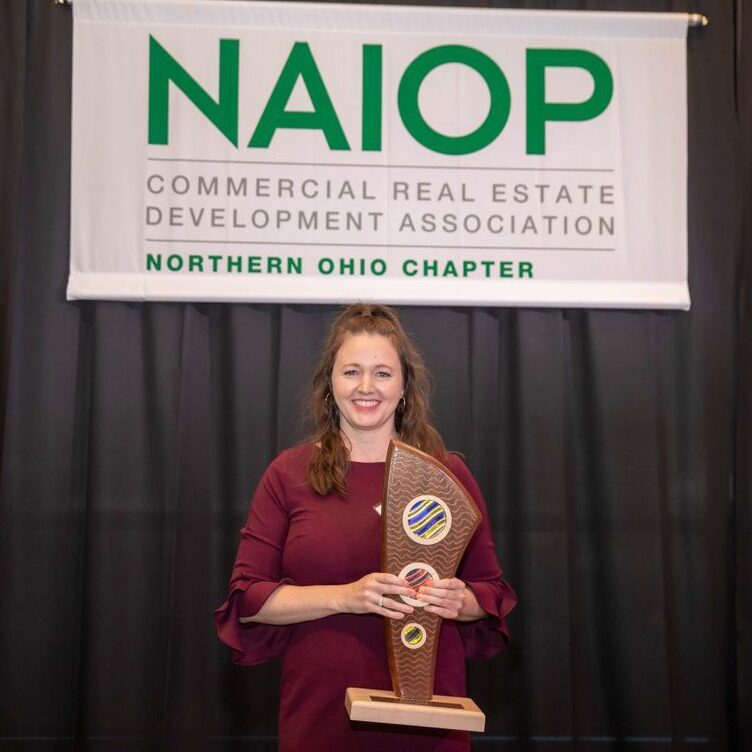
Notice of Public Hearing of Adjustable Rate Educational Facilities Revenue and Refunding Bonds
The Cleveland-Cuyahoga County Port Authority is holding a public hearing to consider the approval of the issuance by the Port Authority of its Adjustable Rate Educational Facilities Revenue and Refunding Bonds. The public hearing will be held on Friday, November 3, 2023 at 10:30 a.m., in the office of the Port Authority located at 1100 West 9th Street, Suite 300, Cleveland, Ohio 44113.
Canadian Seaway strike threatens severe economic consequences; Port of Cleveland makes urgent call for federal intervention
Cleveland – October 25, 2023 – A labor strike by hundreds of Canadian workers along the St. Lawrence Seaway has, in effect, paralyzed a critical maritime trade route connecting the Great Lakes to the Atlantic Ocean. Over 100 vessels remain stranded outside the Seaway system, unable to access it, and this backlog will worsen as the strike endures.
The dispute is between Canadian entities St. Lawrence Seaway Management Corporation and UNIFOR, the union representing its workforce. The striking workers walked off in a labor dispute three days ago, casting a shadow of uncertainty over the extensive economic activities that the St. Lawrence Seaway System supports in both Canada and the United States. This lifeline is not just pivotal for Cleveland but also for North America’s broader economy and transportation network. The strike threatens to disrupt the flow of crucial commodities, including steel for example.
The Port of Cleveland will feel the impact of the strike soon if the matter is not quickly resolved. Annually, the Seaway facilitates the movement of approximately 550,000 metric tons of cargo to and from the Port.
In response to this crisis, the Port of Cleveland has urgently dispatched a letter to the Canadian Ministers of Labor and Transportation, along with U.S. Secretary of Transportation Pete Buttigieg, imploring them to promptly help resolve the labor impasse. (See attached letters)
Will Friedman, President and CEO of the Port of Cleveland, expressed deep concern.
“This shutdown is a matter of grave concern for us and numerous local businesses, given its substantial economic ramifications,” he wrote. “This vital waterway is the linchpin of trade and the movement of goods to and from Cleveland. The interruption is particularly disruptive, occurring just before the end-of-season cargoes are expected, and as winter approaches. The consequences include a halt in exports from Cleveland to overseas destinations, and end-of-year cargoes cannot reach businesses relying on them in Cleveland.
“The longer this stranglehold on commerce in and out of the Great Lakes persists, the more significant the consequences will be,” he continued. “It not only jeopardizes the operations of ships and cargoes but could result in substantial daily economic losses. Ultimately, it may negatively impact Port workers due to dwindling traffic, and severely impact local businesses.”
Friedman said the Port is anticipating several vessels this autumn with imports that are crucial to regional manufacturing, and the longer this crisis endures, it may lead to increased costs for consumers both locally and beyond.
“Much of the high grade imported steel that moves through the Port of Cleveland is destined for local businesses, where it is processed and/or made into products such as nuts, bolts, screws, food grade tin cans, battery casings, automobile parts, and appliances that consumers use daily,” Friedman added in the letter.
Immediate intervention is imperative to avert an escalating economic catastrophe, Friedman said.
# # # #
Port a leader in economic development with financial support for job creation projects
The Port has provided more than $5 billion for 164 projects dating back to 1993, the majority of those within the City of Cleveland. Recent projects funded include:
- $32 million in bond financing for Roundstone Insurance’s new headquarters in Rocky River. This move aims to accommodate the company’s growth and attract local talent, with plans for a three-story building that can house 140 employees and potentially 100 more over the next five years.
- The Port is partnering with the Canton Hall of Fame Village (HOFV) Resort & Entertainment Company to refinance the former McKinley Grand Hotel, now a DoubleTree Hotel. This restructuring of the capital stack and refi is expected to save HOFV more than $5 million. The bonds will be repaid through Tourism and Development District taxes collected at the hotel.
- The Port provided $8 million in TIF bond fund financing for the renovation of the historic downtown Cleveland Renaissance hotel, which will be rebranded into The Cleveland Hotel when completed. The Port partnered with the Development Finance Authority of Summit County which also provided bond fund financing for the project.
Port of Cleveland Recognized with Ohio Auditor's Financial Excellence Award
Port of Cleveland Recognized with Ohio Auditor’s Financial Excellence Award
Cleveland – October 16, 2023— The Port of Cleveland has been honored with the Ohio State Auditor’s Award for Financial Excellence, underscoring the agency’s robust financial health and exemplary management.
“This prestigious award validates the unwavering commitment, meticulous attention to detail, and fiscal responsibility exhibited by our dedicated financial team and leadership,” expressed Carl Naso, the Port’s chief financial officer. “I am exceptionally proud of my team, who consistently perform at the highest standard of financial reporting and accountable government.”
Board Chair J. Stefan Holmes said the award is a testament to Port staff. “We’re very pleased with this award because it shows our commitment to financial accountability, transparency and responsibility to the taxpayers.”
Naso noted that the Port has maintained a spotless audits for at least five consecutive years in the State of Ohio’s audits. This accomplishment signifies that the audit reports have consistently been free from any findings, management recommendations, internal control weaknesses, significant deficiencies, Uniform Guidance (Single Audit) findings or questions regarding costs. Naso has been with the Port for the past six years.
Kathryn Semo, Northeast Regional Liaison, presented the award from Ohio Auditor of State Keith Faber.
“There are not many entities that receive this award,’’ she said, noting that very few of the nearly 6,000 entities which are audited each year are eligible to be considered. “We are happy to have had the opportunity to come in person and present this Auditor of State award to the Port.”
# # # #
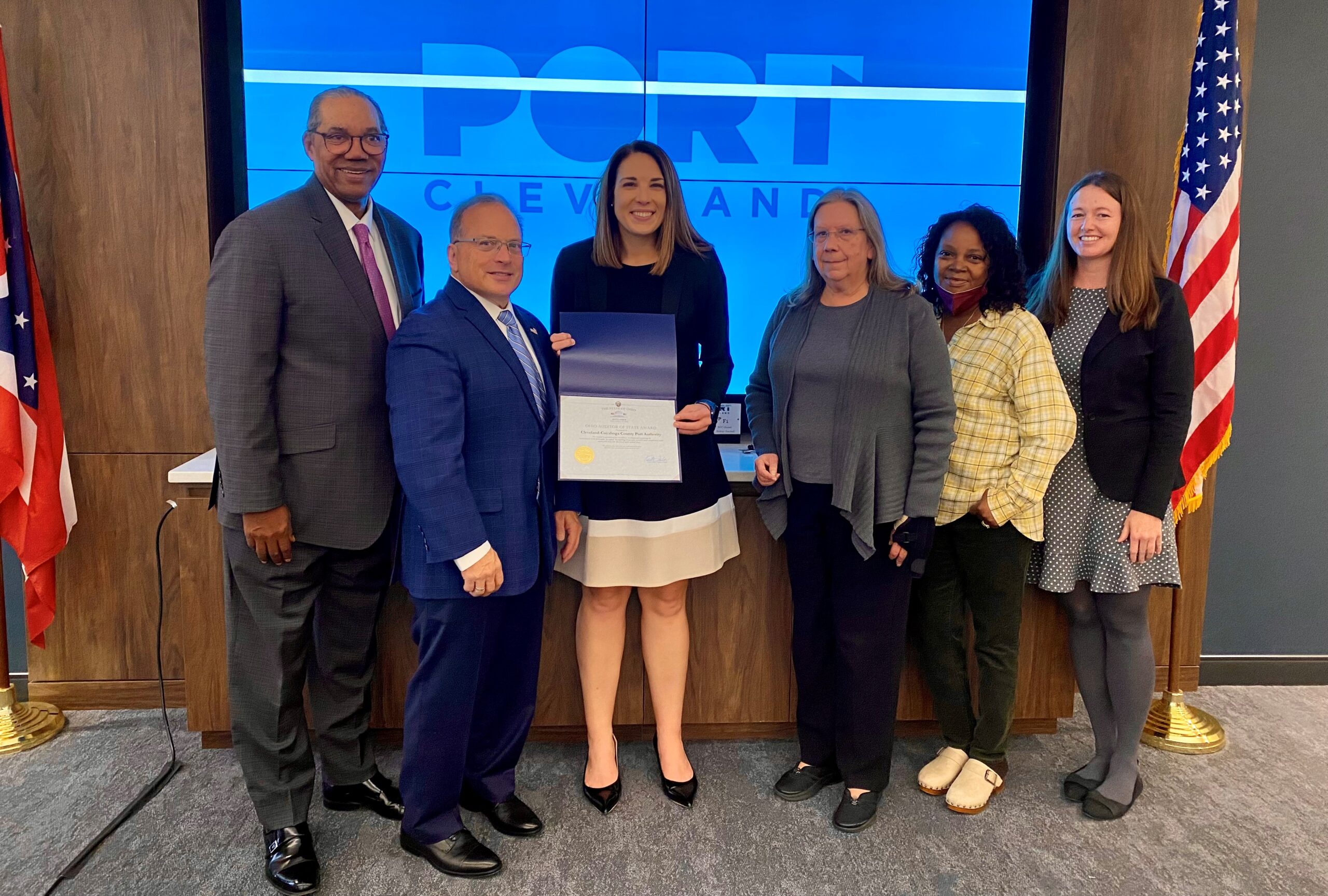
Left to right: Port Board Chairman Stefan Holmes, Carl Naso Port’s Chief Financial Officer, Kathryn Semo, Northeast Regional Liaison, Ohio Auditor of State and Port financial team Margaret Rivalsky, Renee Snipes and Rhonda Winslow. (missing is Justina Dugan).
Port strengthens commitment to environmental sustainability by becoming first port on Great Lakes to implement a Climate Action Plan
Cleveland – September 7, 2023 -- The Port of Cleveland has refreshed its strategic vision to spur job creation, expand economic vitality and advance environmental and recreation opportunities. Particularly noteworthy is a commitment to a Climate Action Plan, with the goal of achieving net-zero greenhouse gas emissions by 2050. The Port of Cleveland is the first port in the Great Lakes to adopt such a plan.
For more than a year, the Port’s board has intensely reviewed the Port’s needs and potential, and undertook a rigorous self-examination to consider how they could optimize the economic potential of being a port community. Numerous public workshops reviewed port operations; facilities; commitment to diversity, equity and inclusion; and other business areas.
“A thriving port serves as the lifeblood of a community,” said Will Friedman, Port President and CEO. “To fulfill our role as an economic powerhouse, we must continually adapt and evolve to meet the ever-changing needs of our community and the global economy. This plan will help serve as a progressive blueprint to sharpen focus, enhance efficiency and strengthen international competitiveness, unlocking the vast potential inherent in being a port community.”
Friedman said the Port is evolving with changing technologies, trade dynamics and environmental sustainability goals.
Cleveland Mayor Justin M. Bibb said the strategic plan is “admirably aggressive in its objectives. It promises focused leadership and allocates resources that will build resiliency to climate change impacts such as increased storm intensity and heavy rainfalls, while also decarbonizing the Port.”
The 2024-2028 Strategic Plan approved by the board of directors today envisions:
Creating new opportunities for business expansion & job growth
The plan identified new opportunities for exporting Ohio-grown products and manufactured merchandise to Europe. The Port is positioned to grow its container business with additional agricultural exports, wood products, lumber and polymers. Liquid bulk materials, namely palm oil, represent a significant revenue growth opportunity.
Project cargo and cruise business also was identified as having great potential for growth and jobs impact.
The Port is also planning to expand the reach of its development financing programs to serve more communities and organizations.
Elevating the Port’s commitment to diversity, equity and inclusion
Recognizing the importance of creating a more equitable landscape, the Port has already increased its minority and female business participation goal from 20% to 30% for port projects.
Going forward, the Port is resolute in its commitment to being both aware and intentional in efforts to encourage and facilitate the engagement of MBE/FBE, small and disadvantaged companies in procurement opportunities. As an integral part of this commitment, the Port will proactively reach out to and support historically disadvantaged businesses, offering them resources and guidance to help them partner with the agency.
The Port will also continue strategic community investments via its Community Impact Fund that uses a portion of development finance fees to make grants targeted at workforce development programs. Through this fund, the Port sponsors the Argonaut partnership for CMSD’s Davis Aviation & Maritime High School with paid internships to work on Flotsam and Jetsam to clear debris from the harbor and river. The fund has awarded $662,000 in grants since its inception in 2018.
“We are deeply committed to advancing diversity, equity and inclusion in all facets of our operations,” Friedman said. “Our aim is to foster a business environment where everyone, regardless of background, has an equal opportunity to contribute to and benefit from the growth and success of the Port.”
Net-Zero by 2050: Incorporating Sustainable Practices Across Port Activities With The Intention Of Becoming One Of The Most Environmentally Responsible Ports In The Nation.
The Port has already taken on sustainability practices including sediment processing/management, stormwater filtration, and planning for electrification of Port equipment, docks and terminals. In addition, the Port today announced it was incorporating “green” in all port business practices, including being one of the first climate action plans among Great Lakes ports.
The goal is to achieve net-zero emissions by 2050, in alignment with the Biden administration’s greenhouse gas reduction targets and goals of the City of Cleveland, Cuyahoga County and the Northeast Ohio Areawide Coordinating Agency
”The Port of Cleveland has long been at the forefront of environmental sustainability, thoughtfully balancing economic vitality with our responsibility to ensure a healthy, clean waterfront for our neighbors and workers,” Friedman said.
“Today, we embark on our most ambitious environmental initiative yet – a Climate Action Plan that charts the path toward net-zero greenhouse gas emissions by 2050,’’ he continued. “While we acknowledge that reaching this ambitious goal demands close collaboration with our industry, community and government partners, the Port has a proven track record of rising to challenges. We wholeheartedly embrace this opportunity to lead the way toward a cleaner, greener future for our region, demonstrating our unwavering commitment to environmental sustainability and the well-being of our community.”
The Port began tracking its air quality impacts in 2016, calculating the pollution emitted from equipment and vehicles associated with port activity, including cargo handling equipment, vessels, harbor craft and trucks. Vessel emissions now are higher than they were in 2016 due to the addition of cruise ships coming through Cleveland and increased activity at the Bulk Terminal. Other emissions sectors are generally lower because equipment is now more efficient.
In addition to the obvious impact on the environment, the Plan positions the Port to better compete for federal grants such as the Congestion Mitigation & Air Quality Improvements grant for the Port’s Advanced Cargo Processing & Fiber Connectivity Project and the Reduction of Truck Emissions at Port Facilities grant program.
The Climate Action Plan addresses action items and areas of focus in buildings and energy efficiency, renewable energy, vehicles and equipment, marine operations and development financing.
Developing Civic Assets By Solving Community Challenges
The Port will continue to lead critical renewal initiatives for river infrastructure and renewal, including the stabilization of Irishtown Bend and leading the Cleveland Harbor Eastern Embayment & Resiliency (CHEERS) project that will create a new lakefront park with open spaces, trails, fishing and other amenities along roughly 80 acres between the East 55th Street Marina and Gordon Park on the city’s east side.
“We are steadfastly committed to balancing a working and recreational waterfront,” said Stefan Holmes, Port Board Chairman. “We have already begun endeavors to build out recreational assets along the riverfront and lake. We are also continuing our efforts to improve the environmental health of the watershed and protect water quality. And, of course, it is critical we continue our focus to ensure unimpeded navigation of the shipping channel and the beneficial re-use of dredged sediments.”
The economic impact of the Port assessed by a leading national transportation economist concluded that, annually, the Port creates:
- 22,368 jobs
- 4.7 billion in economic activity
- $240 million in local and state tax revenue
The 2022 review showed that growth since the last economic impact study in 2016 was $100 million more in state and local income and 2,000+ more jobs. The Port’s development finance capabilities were also assessed – coming in at $5.3 billion secured for 164 projects dating back to 1993. The majority of those projects were within the City of Cleveland.
County Executive Chris Ronayne said he applauds the Port for “this visionary, forward-thinking program that will not only chart the course for the Port’s success, but also position it to become a leader in economic development and environmental sustainability in the country.”
Port of Cleveland kicks off $60 million Irishtown Bend stabilization project at the Cuyahoga River
CLEVELAND, August 25, 2023 – Irish immigrants flocked to Cleveland after the potato famine in the 1840s, and an enclave on the near west side became known as Irishtown Bend, named as such because it was alongside a large curve in the meandering Cuyahoga River. By the 1900s, most Irish residents and other immigrants had left the area. The neighborhood fell into decline and was razed in the 1950s. Fill material was placed on the hillside in the 1960s which combined with a weak clay layer deep beneath the surface, creates the conditions for a catastrophic landslide that would block shipping.
Today, horns blew from vessels on the river and triggered a community celebration and the start of excavators operating to stabilize the hillside. The project is reality now after more than a decade of work and collaboration. The $60 million stabilization project sets the stage to transform the hillside into a 23-acre public park and community amenity, in total a $100 million+ project.
The Port of Cleveland has been leading the effort to stabilize Irishtown Bend since 2010 and credited multiple community stakeholders in getting to this point.
“Today, we add another pivotal marker to the history of Irishtown Bend,” said Port President and CEO William Friedman. “This project would not be happening without the extensive teamwork and financial support of a variety of government and non-profit entities. The danger that this hillside could catastrophically collapse into the shipping channel and impact our $4.7 billion million maritime shipping economy and the 22,000 jobs it supports was very real.”
“Protecting this shipping channel is critical to keep our economy flowing, but also a priority for the Port is maximizing the potential of Cleveland’s waterfront – balancing tourism, public access, recreational uses and, of course, vital job-creating industrial uses. All these things mean economic growth and an improved quality of life,” Friedman continued.
More than $14 million in federal dollars are supporting the project, and Friedman credited Senator Sherrod Brown for being a steadfast advocate on behalf of Greater Cleveland.
“So many of us have fought for so long to get this project done, and today we finally begin this new chapter for our lake and for Cleveland,” said Senator Brown. “The Irishtown Bend project will play an important role in the continued economic resurgence of Northeast Ohio, connecting communities with the lakefront, protecting vital waterways, and encouraging future economic and maritime development.”
Cleveland Mayor Justin Bibb said “No big project in Cleveland gets done in a vacuum. This is a prime example of what can be accomplished when the private and public sectors align on equitable initiative
in support of all Clevelanders. Partners are critical, and I’d like to thank every agency here for looking at the big picture and planning for the future.”
County Executive Chris Ronayne agreed.
“Today is an exciting day, as we watch years of planning turn into action,” he said. “County Executive Chris Ronayne. “The Cuyahoga River valley is seeing a tremendous amount of investment including the completion of the Towpath Trail, the construction of Canal Basin Park, and now the vision for the future of the Veterans Memorial Bridge. The protection and stabilization of Irishtown Bend is critical to our economy and I am thrilled that we’ll soon see a new public space, where nature and the Cuyahoga River can be enjoyed by residents for decades to come.”
Councilman Kerry McCormack said he is looking forward to the years ahead, when the stabilized hillside is home to a new park with extensive views of the river and Cleveland’s downtown skyline.
“This project will dramatically change the Cleveland landscape,” he said. “It is a symbol of Cleveland’s history and a positive reflection of where Cleveland is going. This is so much more than a major infrastructure project, it is also the foundation for equitable access to new high quality public green space for Cleveland residents, including thousands living in public housing, and visitors of all different backgrounds.”
Friedman recognized Grace Gallucci, Executive Director and CEO of the Northeast Ohio Areawide Coordination Agency, for being stalwart in her efforts that helped secure nearly half of the funding for the project.
Gallucci said, “This project is crucial to economic development and quality of life in the region, and that’s why NOACA contributed nearly half of the necessary funding to bring it to fruition.’’
In addition to NOACA and the City, County and Federal governments, Friedman acknowledged other key partners and funders including:
NEORSD
West Creek Conservancy
Ohio City Inc.
LAND studio
Cleveland Metroparks
CMHA
The State of Ohio (including ODNR, ODOT and the Ohio Public Works Commission)
USEPA
The first step in the stabilization process will be to remove fill material placed on the hillside in the 1960s, which will reduce the forces causing the slope failure when combined with the natural geology of the site. That slope failure has eroded and caused the 2007 closure of Riverbed Road and threatens a key sewer line that services Cleveland’s west side, which will be repaired as well. The project also includes installing more than 2,100 linear feet of bulkhead at the river’s edge.
In addition to the more than $14 million in federal funds, the project includes $14.5 million from the State of Ohio and a total of nearly $19 million from the Northeast Ohio Regional Sewer District, the City of Cleveland and Cuyahoga County.
Goettle Inc., a Cincinnati-based company with expertise in deep foundations, earth retention systems and marine construction, is the lead contractor on the stabilization project.
Request for Comments: 2023-2027 Maritime Facilities Development Plan
In accordance with Ohio Revised Code Sections 4582.07 and 4582.08, the Cleveland-Cuyahoga County Port Authority has prepared a Maritime Facilities Development Plan for the years 2023-2027 for the development, construction, and improvement of the maritime facilities of the Port Authority. The Plan includes maps, descriptions, estimated costs, and funding plans for the payment of such facilities.
The Plan is available for review by following the link below.
The Plan may also be obtained at the office of the Cleveland-Cuyahoga County Port Authority at 1100 W. 9th St., Suite 300, Cleveland, OH 44113 during regular business hours of 9:00 a.m. through 4:00 p.m.
Written comments on the Plan may be submitted to Nicholas LaPointe, Vice President, Planning & Capital Development, at Nicholas.LaPointe@portofcleveland.com until September 1, 2023.
The Plan will be presented at the Port Authority Board Meeting held on September 7, 2023 at 9:00 a.m. at 1100 W. 9th St. Cleveland, OH 44113, with an opportunity for public comment.
